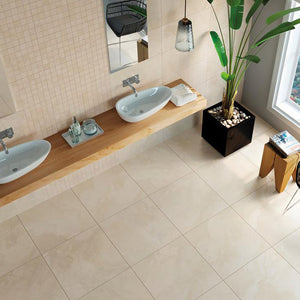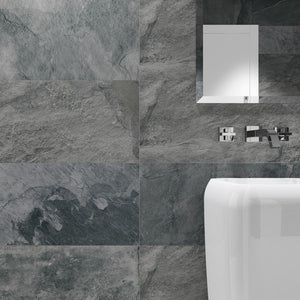Tile
Why choose tile?
Tile can be an excellent flooring option depending on what your needs are. From kitchens and bathrooms to foyers and living areas, tile flooring is extremely versatile, low maintenance, and can be used in a wide variety of settings. Tile is also available in a multitude of different colors and sizes, giving you options for your home’s aesthetic. Plus, you’ll have the comfort of knowing a CTEF-certified tile installation company in Floor Authority. We take pride in our professional and quality floor installations in the Myrtle Beach area.
Shop Tile
Best Selling Tile in Myrtle Beach
SKIP TO SECTION:
Benefits and features of tile
If you’re looking for a stylish flooring option that’s durable, economical, and customizable, tile flooring is a great way to elevate the aesthetics of your home and offers several benefits.
Easy to maintain
Tile flooring is one of the most low-maintenance flooring options. Tile needs to be cleaned but this can be done with just about any product. Every 4-5 years, tile will need to be resealed.
Versatile and durable
Because tile comes in a variety of colors, textures, and materials, it can be used in any room in any home. Its durable nature also makes it perfect for high-traffic or humidity-prone spaces.Long-lasting
Tile flooring has an especially long lifespan. Good-quality tile with proper installation can last anywhere from 30-50 years. Lower-grade tile tends to last a little less at around 20 years.
Eco-friendly
Tile flooring has a low environmental impact. Tile is considered a clean fill material by the EPA. It also minimizes peak heating and cooling, which can reduce energy usage.
Hypoallergenic
Made from natural materials, tile flooring is hypoallergenic. Tile’s hard surfaces don’t trap allergens and dust the way some other flooring materials do.Stylish
From bold shapes to creative patterns, tile is one of the most popular options on the flooring market. Tile flooring comes in a wide variety of styles, colors, textures, and patterns, while looking incredibly realistic.Factors to consider

Style
Tile flooring affords a wide array of style options in size, color, and texture. In addition, with new HD imaging technologies, ceramic tile has become a more durable option in replicating natural stone and even hardwood floors. Regardless of whether you’re going for elegance or just plain durability, you can’t go wrong with tile flooring.
Finish
Tile comes is a variety of finishes, with the most common being matte or polished. To debunk the top myth, polished tile CAN go on floors and has to meeting a slip rating to be rated for the floors. Tiles also come in a number of textures depending on the style of the stile. For example, there are some wood look tiles that have realistic wood graining that give them an authentic wood feel.
Edge and grout lines
The biggest concern with tile is the grout! With advancements in tile technology, grout has become a minute feature of tile that is virtually invisible. With high quality tile comes tighter grout lines, as small as 1/16th of an inch! Tile trends are moving towards to larger format tiles to reduce the number of grout lines. Tile technology has also improved in the construction of tiles with the introduction of the rectified edge. Traditionally, tiles have also had a pressed or chiseled edge, which has a slight bevel and prevents the tiles from sitting too close together. A rectified tile has a square edge that is perfectly flat, allowing for much closer grout lines.
Porcelain vs ceramic
Porcelain and ceramic tile are both clay-based and kiln-fired; however, the clays used to make porcelain have a higher density and are fired at a higher temperature for a longer period of time than ceramic. This means porcelain tile is slightly more durable and water-resistant than ceramic, making it the preferable choice for high-traffic areas. Ceramic tile, on the other hand, can be the better option if you want a more artful, intricate and eye-catching design. Glazed ceramic tiles can be customized in more colors and patterns while some varieties of ceramic tiles have a textured surface that adds visual depth and dimension.
Natural stone
Natural Stone, such as Travertine, Marble, Granite, or Limestone, has a distinct beauty that is virtually unparalleled by any porcelain or ceramic substitute. Although expensive, Natural Stone is a great way to bring natural beauty to your home! Natural stone does require a specialized installer who is familiar working with natural stone.
Avoid cracks
Tiles most commonly crack because of poor installation or expansion in the concrete. When tile is installed, an antifracture membrane should be used across the entire floor.Maintenance tips

Day-to-day maintenance
Tile flooring is one of the easiest surfaces to keep clean. For day-to-day maintenance, you should:
Grout maintenance
Grout can be tricky as it’s prone to tinting and stains, so it’s important to routinely scrub the grout. Scrub with toothbrush and tile cleaner. Apply tile cleaner to the grout and scrub with a toothbrush. For white or light-colored grout, bleach can also be used; however, for tinted grout you’ll want to avoid bleach, which could change the pigment in the grout. First, test cleaners on a discreet area.
Preventative maintenance
Just like other flooring options, there are some preventative measures you should take to ensure longevity of your tile floors.Tile Installation in Myrtle Beach
Get A Free Quote










